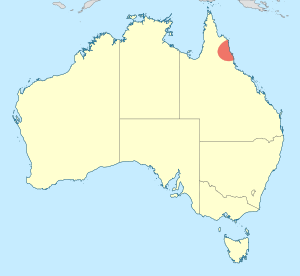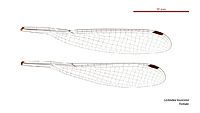Mount Lewis bluestreak facts for kids
Quick facts for kids Mount Lewis bluestreak |
|
|---|---|
| Conservation status | |
| Scientific classification | |
 |
The Mount Lewis bluestreak (scientific name: Lestoidea lewisiana) is a special type of damselfly found only in Australia. It belongs to a family of damselflies called Lestoideidae. This amazing insect is known for its unique home and its striking colors.
It was first officially described in 1996 by a scientist named Günther Theischinger. Since then, it has become an important part of Australia's wildlife.
What is a Damselfly?
Damselflies are insects that look a lot like dragonflies. They are often confused with them! However, damselflies are usually smaller and more slender. When they rest, most damselflies hold their wings together over their back. Dragonflies, on the other hand, usually hold their wings out flat.
Both damselflies and dragonflies belong to an order of insects called Odonata. They are often found near water, like streams, ponds, and lakes. They are important predators, meaning they hunt and eat other small insects.
Where the Bluestreak Lives
The Mount Lewis bluestreak is very rare. It has only ever been found in one place: Mount Lewis. This mountain is located in the beautiful rainforests of north-east Queensland, Australia.
These rainforests are very old and full of unique plants and animals. The bluestreak needs very specific conditions to survive. It lives near clear, flowing streams within the dense rainforest. These streams provide the perfect home for its young, which develop in the water.
What Does It Look Like?
The Mount Lewis bluestreak is a medium to large-sized damselfly. Its body is mostly dark in color. However, it has interesting markings that can be dull orange or even greenish. These colors help it blend in with its rainforest home.
Like all damselflies, it has two pairs of wings. These wings are delicate and clear, allowing it to fly quickly and gracefully through the air. Its large eyes help it spot tiny insects to catch and eat.
Gallery




